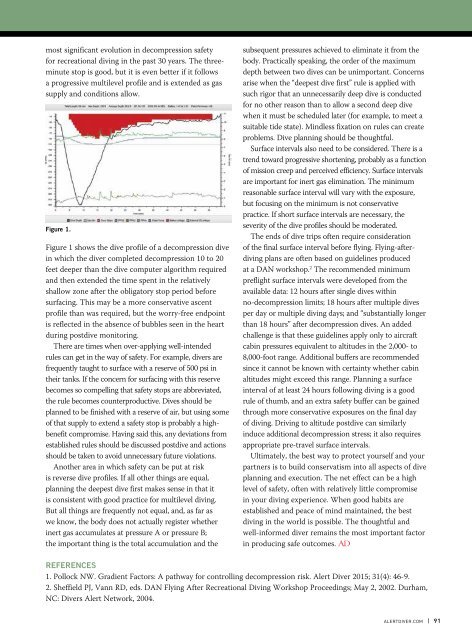AD 2016 Q1
You also want an ePaper? Increase the reach of your titles
YUMPU automatically turns print PDFs into web optimized ePapers that Google loves.
most significant evolution in decompression safety<br />
for recreational diving in the past 30 years. The threeminute<br />
stop is good, but it is even better if it follows<br />
a progressive multilevel profile and is extended as gas<br />
supply and conditions allow.<br />
Figure 1.<br />
Figure 1 shows the dive profile of a decompression dive<br />
in which the diver completed decompression 10 to 20<br />
feet deeper than the dive computer algorithm required<br />
and then extended the time spent in the relatively<br />
shallow zone after the obligatory stop period before<br />
surfacing. This may be a more conservative ascent<br />
profile than was required, but the worry-free endpoint<br />
is reflected in the absence of bubbles seen in the heart<br />
during postdive monitoring.<br />
There are times when over-applying well-intended<br />
rules can get in the way of safety. For example, divers are<br />
frequently taught to surface with a reserve of 500 psi in<br />
their tanks. If the concern for surfacing with this reserve<br />
becomes so compelling that safety stops are abbreviated,<br />
the rule becomes counterproductive. Dives should be<br />
planned to be finished with a reserve of air, but using some<br />
of that supply to extend a safety stop is probably a highbenefit<br />
compromise. Having said this, any deviations from<br />
established rules should be discussed postdive and actions<br />
should be taken to avoid unnecessary future violations.<br />
Another area in which safety can be put at risk<br />
is reverse dive profiles. If all other things are equal,<br />
planning the deepest dive first makes sense in that it<br />
is consistent with good practice for multilevel diving.<br />
But all things are frequently not equal, and, as far as<br />
we know, the body does not actually register whether<br />
inert gas accumulates at pressure A or pressure B;<br />
the important thing is the total accumulation and the<br />
subsequent pressures achieved to eliminate it from the<br />
body. Practically speaking, the order of the maximum<br />
depth between two dives can be unimportant. Concerns<br />
arise when the “deepest dive first” rule is applied with<br />
such rigor that an unnecessarily deep dive is conducted<br />
for no other reason than to allow a second deep dive<br />
when it must be scheduled later (for example, to meet a<br />
suitable tide state). Mindless fixation on rules can create<br />
problems. Dive planning should be thoughtful.<br />
Surface intervals also need to be considered. There is a<br />
trend toward progressive shortening, probably as a function<br />
of mission creep and perceived efficiency. Surface intervals<br />
are important for inert gas elimination. The minimum<br />
reasonable surface interval will vary with the exposure,<br />
but focusing on the minimum is not conservative<br />
practice. If short surface intervals are necessary, the<br />
severity of the dive profiles should be moderated.<br />
The ends of dive trips often require consideration<br />
of the final surface interval before flying. Flying-afterdiving<br />
plans are often based on guidelines produced<br />
at a DAN workshop. 2 The recommended minimum<br />
preflight surface intervals were developed from the<br />
available data: 12 hours after single dives within<br />
no-decompression limits; 18 hours after multiple dives<br />
per day or multiple diving days; and “substantially longer<br />
than 18 hours” after decompression dives. An added<br />
challenge is that these guidelines apply only to aircraft<br />
cabin pressures equivalent to altitudes in the 2,000- to<br />
8,000-foot range. Additional buffers are recommended<br />
since it cannot be known with certainty whether cabin<br />
altitudes might exceed this range. Planning a surface<br />
interval of at least 24 hours following diving is a good<br />
rule of thumb, and an extra safety buffer can be gained<br />
through more conservative exposures on the final day<br />
of diving. Driving to altitude postdive can similarly<br />
induce additional decompression stress; it also requires<br />
appropriate pre-travel surface intervals.<br />
Ultimately, the best way to protect yourself and your<br />
partners is to build conservatism into all aspects of dive<br />
planning and execution. The net effect can be a high<br />
level of safety, often with relatively little compromise<br />
in your diving experience. When good habits are<br />
established and peace of mind maintained, the best<br />
diving in the world is possible. The thoughtful and<br />
well-informed diver remains the most important factor<br />
in producing safe outcomes. <strong>AD</strong><br />
REFERENCES<br />
1. Pollock NW. Gradient Factors: A pathway for controlling decompression risk. Alert Diver 2015; 31(4): 46-9.<br />
2. Sheffield PJ, Vann RD, eds. DAN Flying After Recreational Diving Workshop Proceedings; May 2, 2002. Durham,<br />
NC: Divers Alert Network, 2004.<br />
ALERTDIVER.COM | 91









